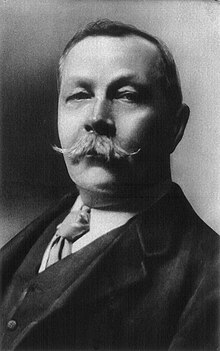About the Book: "The Five Orange Pips", one of the 56 short Sherlock Holmes stories written by British author Sir Arthur Conan Doyle, is the fifth of the twelve stories in The Adventures of Sherlock Holmes.
The story was first published in The Strand magazine in November 1891. Conan Doyle later ranked the story seventh in a list of his twelve favorite Sherlock Holmes stories. This is also one of only two Sherlock Holmes short stories where Holmes' client dies after seeking his help. The other is The Dancing Men.
About the Author: Arthur Ignatius Conan Doyle was born on 22 May 1859 at 11 Picardy Place, Edinburgh, Scotland. From 1876 to 1881, he studied medicine at the University of Edinburgh, including a period working in the town of Aston (now a district of Birmingham) and in Sheffield, as well as in Shropshire at Ruyton-XI-Towns. While studying, Doyle began writing short stories. His earliest extant fiction, "The Haunted Grange of Goresthorpe", was unsuccessfully submitted to Blackwood's Magazine. His first published piece "The Mystery of Sasassa Valley", a story set in South Africa, was printed in Chambers's Edinburgh Journal on 6 September 1879. On 20 September 1879, he published his first non-fiction article, "Gelsemium as a Poison" in the British Medical Journal. In 1882 he joined former classmate George Turnavine Budd as his partner at a medical practice in Plymouth, but their relationship proved difficult, and Doyle soon left to set up an independent practice. Arriving in Portsmouth in June of that year with less than £10 (£900 today) to his name, he set up a medical practice at 1 Bush Villas in Elm Grove, Southsea. The practice was initially not very successful. While waiting for patients, Doyle again began writing stories and composed his first novels, The Mystery of Cloomber, not published until 1888, and the unfinished Narrative of John Smith, which would go unpublished until 2011. He amassed a portfolio of short stories including "The Captain of the Pole-Star" and "J. Habakuk Jephson's Statement", both inspired by Doyle's time at sea, the latter of which popularized the mystery of the Mary Celeste and added fictional details such as the perfect condition of the ship (which had actually taken on water by the time it was discovered) and its boats remaining on board (the one boat was in fact missing) that have come to dominate popular accounts of the incident. Doyle struggled to find a publisher for his work. His first significant piece, A Study in Scarlet, was taken by Ward Lock Co. on 20 November 1886, giving Doyle £25 for all rights to the story. The piece appeared later that year in the Beeton's Christmas Annual and received good reviews in The Scotsman and the Glasgow Herald. The story featured the first appearance of Watson and Sherlock Holmes, partially modeled after his former university teacher Joseph Bell. Doyle wrote to him, "It is most certainly to you that I owe Sherlock Holmes ... Round the center of deduction and inference and observation which I have heard you inculcate I have tried to build up a man." Robert Louis Stevenson was able, even in faraway Samoa, to recognize the strong similarity between Joseph Bell and Sherlock Holmes: "My compliments on your very ingenious and very interesting adventures of Sherlock Holmes. ... Can this be my old friend Joe Bell?" Other authors sometimes suggest additional influences—for instance, the famous Edgar Allan Poe character C. Auguste Dupin. A sequel to A Study in Scarlet was commissioned and The Sign of the Four appeared in Lippincott's Magazine in February 1890, under agreement with the Ward Lock company. Doyle felt grievously exploited by Ward Lock as an author new to the publishing world and he left them. Short stories featuring Sherlock Holmes were published in the Strand Magazine. Doyle first began to write for the 'Strand' from his home at 2 Upper Wimpole Street, now marked by a memorial plaque. In this period, however, Holmes was not his sole subject and in 1893, he collaborated with J.M. Barrie on the libretto of Jane Annie. Doyle was found clutching his chest in the hall of Windlesham Manor, his house in Crowborough, East Sussex, on 7 July 1930. He died of a heart attack at the age of 71. His last words were directed toward his wife: "You are wonderful." At the time of his death, there was some controversy concerning his burial place, as he was avowedly not a Christian, considering himself a Spiritualist. He was first buried on 11 July 1930 in Windlesham rose garden. He was later reinterred together with his wife in Minstead churchyard in the New Forest, Hampshire. Carved wooden tablets to his memory and to the memory of his wife are held privately and are inaccessible to the public. That inscription reads, "Blade straight / Steel true / Arthur Conan Doyle / Born May 22nd 1859 / Passed On 7th July 1930." The epitaph on his gravestone in the churchyard reads, in part: "Steel true/Blade straight/Arthur Conan Doyle/Knight/Patriot, Physician, and man of letters". Undershaw, the home near Hindhead, Haslemere, south of London, that Doyle had built and lived in between October 1897 and September 1907, was a hotel and restaurant from 1924 until 2004. It was then bought by a developer and stood empty while conservationists and Doyle fans fought to preserve it. In 2012 the High Court ruled that the redevelopment permission be quashed because proper procedure had not been followed. A statue honours Doyle at Crowborough Cross in Crowborough, where he lived for 23 years. There is also a statue of Sherlock Holmes in Picardy Place, Edinburgh, close to the house where Doyle was born.
 |
| Add caption |
Not being married, Elias had allowed his nephew to stay at his estate. Strange incidents have occurred; one is that although John could go anywhere in the house he could never enter a locked room containing his uncle's trunks. Another peculiarity was that in March 1883 a letter postmarked Pondicherry, in India, arrived for the Colonel inscribed only "K.K.K." with five orange pips enclosed.
More strange things happened: Papers from the locked room were burnt and a will was drawn up leaving the estate to John Openshaw. The Colonel's behavior became bizarre. He would either lock himself in his room and drink or he would go shouting forth in a drunken sally with a pistol in his hand. On 2 May 1883 he was found dead in a garden pool.
On 4 January 1885 Elias's brother Joseph receives a letter postmarked Dundee with the initials "K.K.K" and instructions to leave "the papers" on the sundial. Despite his son's urging, Joseph Openshaw refuses to call the police. Three days later, Joseph Openshaw is found dead in a chalk-pit. The only clue John Openshaw can furnish Holmes is a page from his uncle's diary marked March 1869 in which orange pips have been sent to three men, of whom two flee and the third has been "visited".
Holmes advises Openshaw to leave the diary page with a note telling of the destruction of the Colonel's papers on the garden sundial. After Openshaw leaves, Holmes deduces from the time that has passed between the letter mailings and the deaths of Elias and his brother that the writer is on a sailing ship.
Holmes also recognizes the "K.K.K" as Ku Klux Klan, an anti-Reconstruction group in the South until its sudden collapse in March 1869 – and theorizes that this collapse was the result of the Colonel's maliciously taking their papers away to England.
The next day there is a newspaper account that the body of Openshaw has been found in the River Thames and the death is believed to be an accident. Holmes checks sailing records of ships who were at both Pondicherry in January/February 1883 and at Dundee in January 1885 and recognizes a Georgia sloop named The Lone Star. Lone Star may refer to the Lone Star State, Texas, although the boat is registered to Georgia. Furthermore Holmes confirms that The Lone Star had docked in London a week before. Holmes sends five orange pips to the captain of The Lone Star, and then sends a telegram to the Savannah police claiming that the captain and two mates are wanted for murder. The Lone Star never arrives in Savannah due to a severe gale. The only trace of the boat is a mast marked "L.S." sighted in the North Atlantic.
I recommend this book to any reader who appreciates mysteries and Sherlock Holmes in particular. You will not be disappointed.
I recommend this book to any reader who appreciates mysteries and Sherlock Holmes in particular. You will not be disappointed.


No comments:
Post a Comment